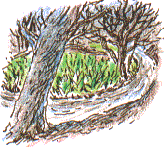
 
The Cover of the Rushes
Friday 10th
March 2000




 Nature Diary
Rocks
History
Gallery
Links
Home Page
Nature Diary
Rocks
History
Gallery
Links
Home Page

 FOUR MAGPIES fly over the wood. Other birds fly in incognito in small flocks, but magpies are always a collection of individuals, reacting to each other, arguing with each other.
FOUR MAGPIES fly over the wood. Other birds fly in incognito in small flocks, but magpies are always a collection of individuals, reacting to each other, arguing with each other.
 Since we were last in the wood the Wild Garlic, or Ransoms as it is also called, has become established on the banks of the stream, turning brown debris-strewn ground to a fresh lush green.
Since we were last in the wood the Wild Garlic, or Ransoms as it is also called, has become established on the banks of the stream, turning brown debris-strewn ground to a fresh lush green.  As yet, we don't get that whiff of garlic as we enter the wood. It's something of a minor miracle, the greening of the woodland floor. I worry about the housing development coming right up to the entrance of the woods. How much capacity do the woods have for regeneration? . . . an awful lot it seems. As yet, we don't get that whiff of garlic as we enter the wood. It's something of a minor miracle, the greening of the woodland floor. I worry about the housing development coming right up to the entrance of the woods. How much capacity do the woods have for regeneration? . . . an awful lot it seems.
 There are green catkins on a Pussy Willow down the Balk lane. These look like female catkins, the ones that will produce fluffy seeds in May. The male catkins, which will soon be covered in yellow pollen, are on separate bushes,
There are green catkins on a Pussy Willow down the Balk lane. These look like female catkins, the ones that will produce fluffy seeds in May. The male catkins, which will soon be covered in yellow pollen, are on separate bushes, as this willow is dioecious; each bush is either male or female. Pussy Willow, Salix caprea, is also known as Goat Willow or Sallow. The leaves were used to feed goats. Considering the range of plants that goats will eat it's curious that the name should have stuck to this plant in particular. as this willow is dioecious; each bush is either male or female. Pussy Willow, Salix caprea, is also known as Goat Willow or Sallow. The leaves were used to feed goats. Considering the range of plants that goats will eat it's curious that the name should have stuck to this plant in particular.
  There's such a wind blowing that we don't see much birdlife on our walk. The Wrens are singing like furious little power packs in the wood. Rival Robins battle it out from their perches at either side of the road in a clear wistful trickle of song. A Blackbird balanced precariously somewhere in a windswept tree above us is singing in an incongruously laid back and melodious fashion, as relaxed as the crooning of Bing Crosby, except he didn't sing clinging to the swaying branches of a tree.
There's such a wind blowing that we don't see much birdlife on our walk. The Wrens are singing like furious little power packs in the wood. Rival Robins battle it out from their perches at either side of the road in a clear wistful trickle of song. A Blackbird balanced precariously somewhere in a windswept tree above us is singing in an incongruously laid back and melodious fashion, as relaxed as the crooning of Bing Crosby, except he didn't sing clinging to the swaying branches of a tree.
  We see just a single Coot and a pair of Mallards on the rushy field. I suspect that there are more water birds sheltering in the cover of the rushes.
We see just a single Coot and a pair of Mallards on the rushy field. I suspect that there are more water birds sheltering in the cover of the rushes.

Richard Bell,
wildlife illustrator
E-mail; 'richard@daelnet.co.uk'
 Next day
Previous day
Nature Diary
Wild West Yorkshire home page
Next day
Previous day
Nature Diary
Wild West Yorkshire home page

|

 FOUR MAGPIES fly over the wood. Other birds fly in incognito in small flocks, but magpies are always a collection of individuals, reacting to each other, arguing with each other.
FOUR MAGPIES fly over the wood. Other birds fly in incognito in small flocks, but magpies are always a collection of individuals, reacting to each other, arguing with each other.
 FOUR MAGPIES fly over the wood. Other birds fly in incognito in small flocks, but magpies are always a collection of individuals, reacting to each other, arguing with each other.
FOUR MAGPIES fly over the wood. Other birds fly in incognito in small flocks, but magpies are always a collection of individuals, reacting to each other, arguing with each other.